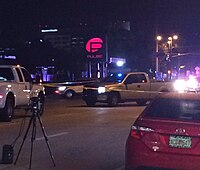
Photo from wikipedia
One of the tools for estimating shooting distance is examination of smokeless powder particle distribution on the target area. Components of the powder that are utilized for this purpose are… Click to show full abstract
One of the tools for estimating shooting distance is examination of smokeless powder particle distribution on the target area. Components of the powder that are utilized for this purpose are nitrite anions. The traditional method for detecting nitrite anions mainly involves applying the Griess Test. A known‐distance test firing is performed with shootings done at several distances from different targets. The color pattern corresponding to nitrite anions from the crime scene is then compared to the patterns obtained from known distances of the test firing. When a mutual shooting takes place at the crime scene, and a shooter also becomes a shootout victim, it is possible that when examining the shooter as a victim (i.e. target), additional nitrite‐containing particles, resulting from his/her shooting, will be present on the shooter‐victim clothing. This kind of addition may affect the estimation and practically give a shorter‐distance estimation comparing to the actual distance. In this paper, an experimental setup was designed in order to understand if nitrite‐containing particles were added to a victim as a consequence of him/her being also a shooter. All of the experiments were predominantly designed to try and minimize the effects of other influencing factors and variables in order to examine if the additions resulting from the firing action affect distance estimation. The experiments involved various types of pistols and distances. The results show that in such a scenario, there are marginal additions of nitrite signals on the victim's shirt. Although the forensic expert's final assessment was within the tolerance interval at all distances, caution should be exercised when attempting to estimate shooting distances in scenarios where the victim also shoots.
Journal Title: Journal of Forensic Sciences
Year Published: 2022
Link to full text (if available)
Share on Social Media: Sign Up to like & get
recommendations!